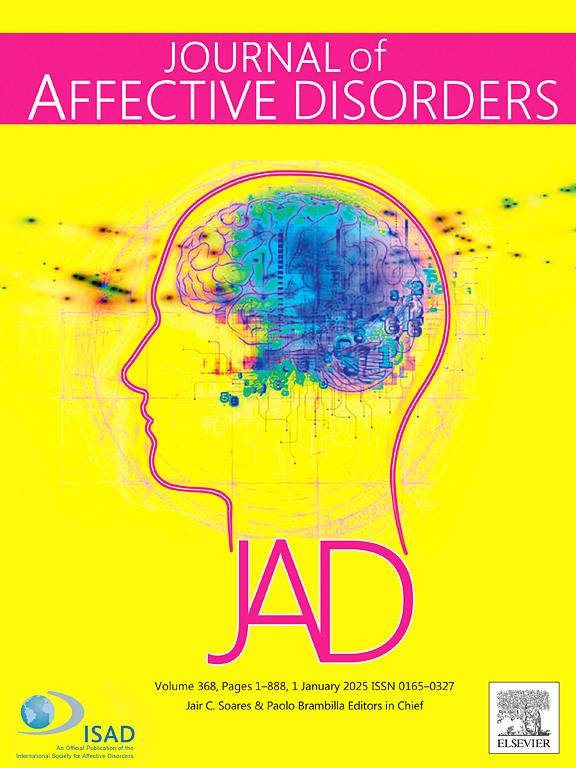青少年早期抑郁症状的发展轨迹:中国南充一项为期12个月的队列研究
IF 4.9
2区 医学
Q1 CLINICAL NEUROLOGY
引用次数: 0
摘要
背景:青春期是心理健康发展的关键时期,但从儿童期到青春期早期抑郁症状的纵向模式仍未得到充分研究。本研究确定了中国初中生抑郁症状的不同发展轨迹,并探讨了其社会人口学和行为预测因素。方法:采用中国南充市2635名七年级至八年级学生(2022-2023)的纵向数据,通过流行病学研究中心抑郁量表(CES-D)每隔三个月评估一次抑郁症状。基于群体的轨迹模型(GBTM)识别了潜在的轨迹类别,多项逻辑回归分析了类别隶属度的预测因子。结果:抑郁症状的患病率在各波间呈上升趋势(13.40 %,21.56 %,26.94 %)。出现了三种轨迹分类:持续低症状,即低风险(27.40 %),持续升高的症状,高风险(28.54 %),急剧增加的症状,进展风险(44.06 %)。女性、留守状态、重组的家庭结构、较短的睡眠时间、较长的屏幕时间和较少的体育活动都预示着高风险类别(调整后的优势比[aOR]范围:1.4-3.2)和进展风险类别的成员。较低的父母受教育程度与进展风险等级唯一相关(aOR = 0.8,P )局限性:主要局限性包括相对较短的观察窗口、区域限制性抽样、潜在的未测量混杂因素以及自我报告测量的固有主观性,这些可能影响研究结果的解释和推广。结论:四川省南充市青少年抑郁症状的发展轨迹具有显著的异质性,受个体、家族和行为因素的交叉影响。早期识别高风险亚群,针对可改变的预测因素(如睡眠卫生、电子产品过度使用)进行量身定制的干预——锚定在基线风险概况上,并通过纵向监测进行适应性改进——可能减轻这一脆弱发育窗口期的心理健康负担。本文章由计算机程序翻译,如有差异,请以英文原文为准。
Developmental trajectories of depressive symptoms during early adolescence: A 12-month cohort study in Nanchong, China
Background
Adolescence marks a critical period for mental health development, yet longitudinal patterns of depressive symptoms during the transition from childhood to early adolescence remain understudied. This study identifies distinct developmental trajectories of depressive symptoms in Chinese junior school students and examines their sociodemographic and behavioral predictors.
Methods
Using longitudinal data from 2635 seventh- to eighth-grade students in Nanchong, China (2022–2023), depressive symptoms were assessed at three six-month intervals via the Center for Epidemiologic Studies Depression Scale (CES-D). Group-based trajectory modeling (GBTM) identified latent trajectory classes, and multinomial logistic regression analyzed predictors of class membership.
Results
Prevalence rates of depressive symptoms increased across waves (13.40 %, 21.56 %, 26.94 %). Three trajectory classes emerged: Consistently low symptoms, namely, Low-risk (27.40 %), Persistently elevated symptoms, high-risk (28.54 %), Steeply increasing symptoms, progressing-risk (44.06 %). Female gender, left-behind status, reconstituted family structure, shorter sleep duration, prolonged screen time, and infrequent physical activity predicted membership in both high-risk (adjusted odds ratio [aOR] range: 1.4–3.2) and progressing-risk classes. Lower parental education levels were uniquely associated with the progressing-risk class (aOR = 1.27, P < 0.05).
Limitations
Key limitations include the relatively short observation window, regionally restricted sampling, potential unmeasured confounders, and the inherent subjectivity of self-reported measures, which may affect the interpretation and generalizability of the findings.
Conclusion
Depressive symptom trajectories among adolescents in Nanchong, Sichuan Province demonstrate substantial heterogeneity, shaped by intersecting individual, familial, and behavioral factors. Early identification of high-risk subgroups and tailored interventions targeting modifiable predictors (e.g., sleep hygiene, digital overuse)—anchored to baseline risk profiles and adaptively refined through longitudinal monitoring—may mitigate mental health burdens during this vulnerable developmental window.
求助全文
通过发布文献求助,成功后即可免费获取论文全文。
去求助
来源期刊

Journal of affective disorders
医学-精神病学
CiteScore
10.90
自引率
6.10%
发文量
1319
审稿时长
9.3 weeks
期刊介绍:
The Journal of Affective Disorders publishes papers concerned with affective disorders in the widest sense: depression, mania, mood spectrum, emotions and personality, anxiety and stress. It is interdisciplinary and aims to bring together different approaches for a diverse readership. Top quality papers will be accepted dealing with any aspect of affective disorders, including neuroimaging, cognitive neurosciences, genetics, molecular biology, experimental and clinical neurosciences, pharmacology, neuroimmunoendocrinology, intervention and treatment trials.
 求助内容:
求助内容: 应助结果提醒方式:
应助结果提醒方式:


